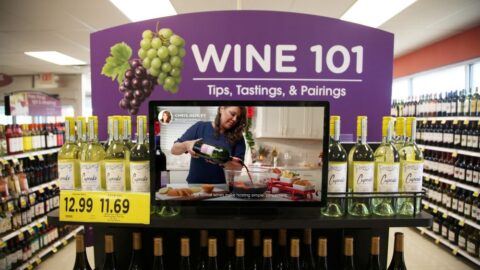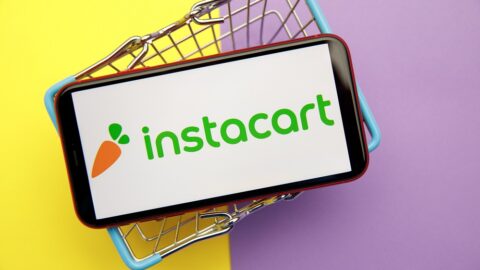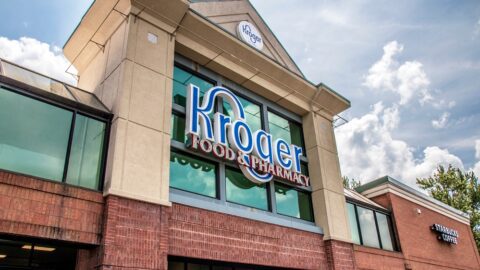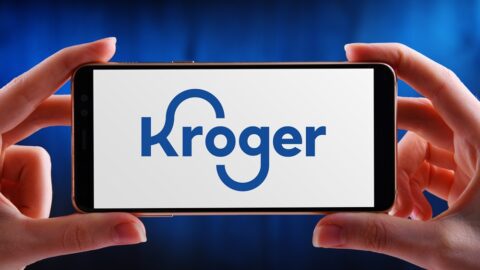In its latest push to drive forward its Restock Kroger initiative, the retailer is partnering with Microsoft to pilot a connected store experience and jointly market a commercial retail-as-a-service (RaaS) offering to other retailers. The two pilot stores are located in Kroger’s home city, Cincinnati, Ohio, and the Redmond, Wash. headquarters of Microsoft. Results of the pilot will guide expansion plans in 2019 and beyond, according to a joint statement.
To provide a guided, personalized shopping experience, the stores will leverage the Microsoft Azure cloud technology and connected IoT sensors to bridge Kroger’s proprietary EDGE (Enhanced Display for Grocery Environment) shelf-edge screen technology with its Scan, Bag, Go mobile checkout feature. Customers using Kroger’s self-checkout app will be guided through the store to items on their shopping list, and will encounter personalized icons on digital shelves that are below the next relevant product on their list.
The EDGE shelves use digital displays rather than traditional paper tags to provide shoppers with information such as prices, promotions and nutritional and dietary information. The system debuted in fall 2018 and can now be found at the end of the aisles at 92 Kroger locations, according to Bloomberg.
Kroger has sought to combine the EDGE and Scan, Bag, Go technologies to improve the “digitization” of the store for more than a year, with EVP and CIO Chris Hjelm sharing initial plans for the technology with Retail TouchPoints in February 2018
“Say you’re a gluten-free consumer and you’re shopping for nutrition bars,” Hjelm said. “There might be 100 or more options in some stores, so how do I help you find the gluten-free ones? With the locationing technology that’s built into Scan, Bag, Go-equipped digital devices, combined with the shelf-edge technologies, we would be able to highlight the gluten-free bars for you. This is in a potential future, but I see it happening sooner rather than later…We also have an endcap version [of the shelf display] with full color, high-definition quality — you can literally play videos at the shelf edge.”
The concept stores also are designed to assist store associates, providing them with visual cues to help them find items quickly. This technology can reduce the time needed to fulfill curbside pickup orders. Additionally, Microsoft Azure-powered video analytics can help associates identify and address out-of-stocks, to ensure customers can locate products on their shopping list.
The grocery giant has been proactive in partnering with other retailers to overhaul its customer experience, collaborating with UK-based online grocer Ocado to build out 20 automated warehouses in the U.S.; adding Kroger Express, a curated assortment of 2,300 products, at 13 Walgreens stores in northern Kentucky; and even resurrecting the Toys ‘R’ Us brand at 600 stores for the holiday season. Additionally, Kroger partnered with Alibaba late in 2018 to sell select natural and organic products on Tmall.
Grocers are realizing that they must embrace new technologies if they want to win the hearts and wallets of the consumer. Hannaford, the 181-store supermarket chain owned by Ahold Delhaize, opened a tech-focused pilot store in Portland, Maineopened a tech-focused pilot store in Portland, Maine earlier in January. As in the Kroger stores, connected shelves are the main selling point. The shelves include sensors to determine which product a customer has picked up, as well as fixed tablet screens for customers to browse detailed product information about items.
In its latest push to drive forward its Restock Kroger initiative, the retailer is partnering with Microsoft to pilot a connected store experience and jointly market a commercial retail-as-a-service (RaaS) offering to other retailers. The two pilot stores are located in Kroger’s home city, Cincinnati, Ohio, and the Redmond, Wash. headquarters of Microsoft. Results of the pilot will guide expansion plans in 2019 and beyond, according to a joint statement.
To provide a guided, personalized shopping experience, the stores will leverage the Microsoft Azure cloud technology and connected IoT sensors to bridge Kroger’s proprietary EDGE (Enhanced Display for Grocery Environment) shelf-edge screen technology with its Scan, Bag, Go mobile checkout feature. Customers using Kroger’s self-checkout app will be guided through the store to items on their shopping list, and will encounter personalized icons on digital shelves that are below the next relevant product on their list.
The EDGE shelves use digital displays rather than traditional paper tags to provide shoppers with information such as prices, promotions and nutritional and dietary information. The system debuted in fall 2018 and can now be found at the end of the aisles at 92 Kroger locations, according to Bloomberg.
Kroger has sought to combine the EDGE and Scan, Bag, Go technologies to improve the “digitization” of the store for more than a year, with EVP and CIO Chris Hjelm sharing initial plans for the technology with Retail TouchPoints in February 2018
“Say you’re a gluten-free consumer and you’re shopping for nutrition bars,” Hjelm said. “There might be 100 or more options in some stores, so how do I help you find the gluten-free ones? With the locationing technology that’s built into Scan, Bag, Go-equipped digital devices, combined with the shelf-edge technologies, we would be able to highlight the gluten-free bars for you. This is in a potential future, but I see it happening sooner rather than later…We also have an endcap version [of the shelf display] with full color, high-definition quality — you can literally play videos at the shelf edge.”
The concept stores also are designed to assist store associates, providing them with visual cues to help them find items quickly. This technology can reduce the time needed to fulfill curbside pickup orders. Additionally, Microsoft Azure-powered video analytics can help associates identify and address out-of-stocks, to ensure customers can locate products on their shopping list.
The grocery giant has been proactive in partnering with other retailers to overhaul its customer experience, collaborating with UK-based online grocer Ocado to build out 20 automated warehouses in the U.S.; adding Kroger Express, a curated assortment of 2,300 products, at 13 Walgreens stores in northern Kentucky; and even resurrecting the Toys ‘R’ Us brand at 600 stores for the holiday season. Additionally, Kroger partnered with Alibaba late in 2018 to sell select natural and organic products on Tmall.
Grocers are realizing that they must embrace new technologies if they want to win the hearts and wallets of the consumer. Hannaford, the 181-store supermarket chain owned by Ahold Delhaize, opened a tech-focused pilot store in Portland, Maine earlier in January. As in the Kroger stores, connected shelves are the main selling point. The shelves include sensors to determine which product a customer has picked up, as well as fixed tablet screens for customers to browse detailed product information about items.













